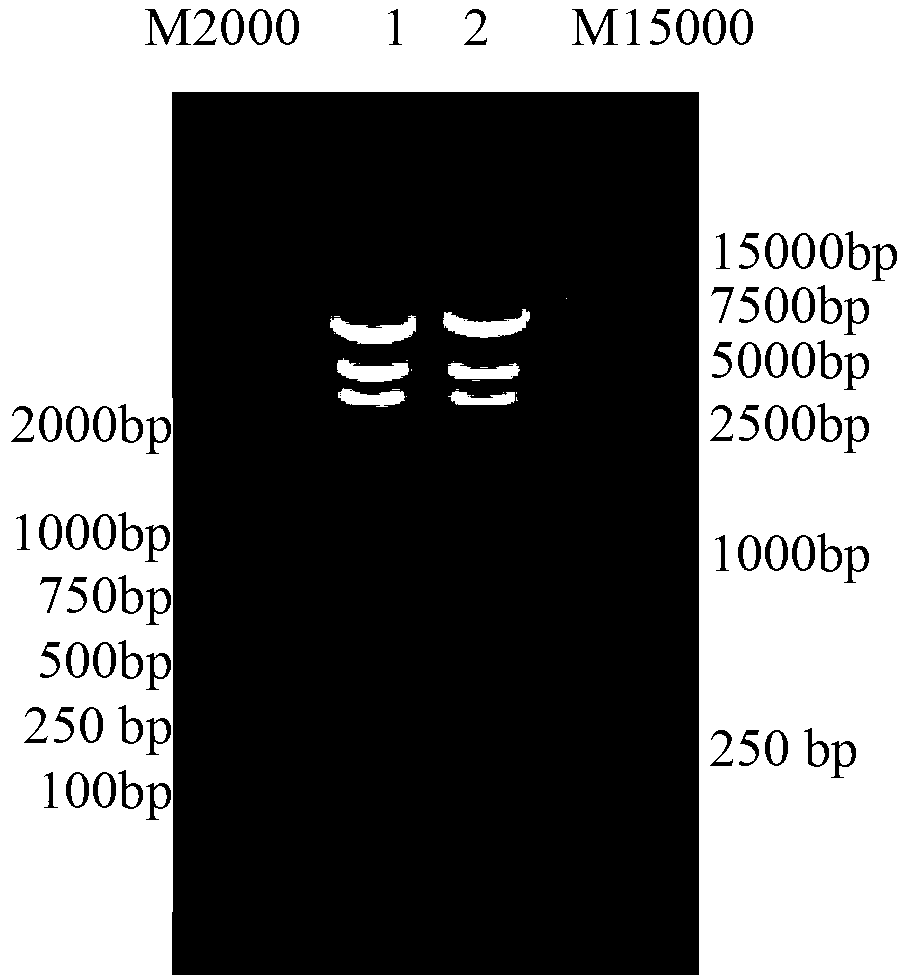DNA (Deoxyribonucleic acid) segment and applications thereof in constructing HCV (hepatitis C virus) whole-genome expression animal model
A whole genome and fragment technology, applied in DNA/RNA fragments, recombinant DNA technology, cells modified by introducing foreign genetic material, etc., can solve the problems of not reflecting antiviral effect, immunopathological damage, etc.
- Summary
- Abstract
- Description
- Claims
- Application Information
AI Technical Summary
Problems solved by technology
Method used
Image
Examples
Embodiment 1
[0036] Embodiment 1, construction contains the recombinant vector of DNA segment of the present invention
[0037] 1. Using the method of overlapping PCR in the plasmid pJFH1 (document: Production of Infectious Hepatitis C Virus in Tissue Culture from A Cloned Viral Genome. Nat. Med, 2005; 11 (7): 791-796. The public can obtain it from the Chinese People's Liberation Army Military Acquired by the Institute of Microbial Epidemiology, Academy of Medical Sciences) the HCV whole genome gene (shown in the 486th-10220th position of the sequence listing sequence 1) downstream forwardly connects the hepatitis D virus (HDV) ribozyme gene sequence (the sequence listing sequence 1 position 10221-10308), to obtain recombinant vector A;
[0038] 2. In order to avoid the potential impact of the prokaryotic promoter on the expression of HCV in the transgenic animal, the prokaryotic promoter T7 upstream of the HCV whole genome gene in the recombinant vector A obtained in step 1 was removed to...
Embodiment 2
[0043] Embodiment 2, utilize the transgenic animal prepared and identification of the DNA fragment of the present invention
[0044] The recombinant vector pTRE2-HCV-ribo-delete7 obtained in Example 1 was used with XbaI (the recognition sequence is T^CTAGA, located at the 10308-10313th position of sequence listing sequence 1) and PvuI (the recognition sequence is CGAT^CG, located in the sequence listing The 12919-12924 position of Sequence 1) was double-enzymatically digested, and the 10924bp large fragment was recovered, and the prokaryotic DNA of C57BL / 6×CBA F1 mouse fertilized eggs (Guangzhou Saiye Biotechnology Co., Ltd.) was microinjected, and the injected eggs were respectively Transplanted into the fallopian tubes of pseudopregnant female mice, cut the tail of about 0.5 cm from the second week after birth, and extracted genomic DNA for PCR identification. The primer sequences are as follows:
[0045] HCV-F: 5'-CTTGTTGTGCCCTACGGATTG-3';
[0046] HCV-R: 5'-TGAAGGTGGAGAAG...
Embodiment 3
[0049] Example 3, Preparation of Tet-on-HCV Double Transgenic Mice and Identification of Gene Integration
[0050] The transgenic mouse "albumin-rtTA transgenic" that specifically expresses rtTA in the liver tissue regulated by the mouse albumin promoter (document: Xiao-Jun Zhou et al. Over-expression of uPA increases risk of liver injury in pAAV-HBV transfected mice.World J Gastroenterol 2012,18:1892-1902. The public can obtain it from the Institute of Microbial Epidemiology, Academy of Military Medical Sciences of the Chinese People’s Liberation Army) and TRE2-HCV transgenic mice, PCR identification of both integrated rtTA and HCV genome-wide genes Double transgenic mice. The identification primers and PCR conditions of HCV whole genome gene integration are the same as in Example 2, and the integration identification primers of rtTA are as follows:
[0051] rtTA-F:5'-GTGCAGCTTGGCTTGAACTCGTTC-3';
[0052] rtTA-R:5'-GAGTATGGTGCCTATCTAACATCTC-3';
[0053] The PCR reaction sy...
PUM
 Login to View More
Login to View More Abstract
Description
Claims
Application Information
 Login to View More
Login to View More - R&D
- Intellectual Property
- Life Sciences
- Materials
- Tech Scout
- Unparalleled Data Quality
- Higher Quality Content
- 60% Fewer Hallucinations
Browse by: Latest US Patents, China's latest patents, Technical Efficacy Thesaurus, Application Domain, Technology Topic, Popular Technical Reports.
© 2025 PatSnap. All rights reserved.Legal|Privacy policy|Modern Slavery Act Transparency Statement|Sitemap|About US| Contact US: help@patsnap.com



